E-3 Visa Sponsorship Jobs in USA for Foreigners 2025
The United States is a desirable destination for international professionals due to its strong economy and diverse job opportunities. One of the best ways for Australian nationals to work in the U.S. is through the E-3 visa, which provides a unique opportunity for skilled professionals.
This guide will cover the E-3 visa, its benefits, application process, and how to find employers willing to sponsor candidates.
Check Also: H2B Visa Sponsorship Jobs in USA – Apply Now
What is an E-3 Visa?
The E-3 visa is a non-immigrant work visa exclusively available to Australian citizens. Established under the Australia-United States Free Trade Agreement (AUSFTA), it allows professionals with specialized skills to work in the U.S.
E-3 Visa Sponsorship Jobs in USA for Foreigners 2025:
Common roles that qualify for E-3 visa sponsorship include:
- Immigration Specialist II
- Analytical Chemist
- Recruiter
- Test Technician, Biomass
- Software Developer
- Highway Construction Project Engineer
Eligibility for the E-3 Visa:
To qualify for an E-3 visa, applicants must:
- Be an Australian citizen
- Have a valid job offer from a U.S. employer
- Work in a specialty occupation (requiring specialized knowledge and a bachelor’s degree)
- Meet educational and experience requirements
Benefits:
- Exclusive to Australians – Limits competition with other nationalities.
- Specialty Occupations – Covers diverse fields such as IT, healthcare, finance, engineering, and education.
- Unlimited Renewals – The E-3 visa can be renewed indefinitely in two-year increments.
- Work Authorization for Spouses – Spouses of E-3 visa holders can apply for Employment Authorization (EAD) and work in the U.S.
- No Quota Limits – Unlike the H-1B visa, the E-3 visa has a high annual cap (10,500 visas) that is rarely met.
- Faster Processing – E-3 visas are processed quickly by U.S. consulates in Australia.
- No Prevailing Wage Determination – Employers must pay the market rate but do not need formal Department of Labor certification.
E-3 Visa Application Process:
Step 1: Secure a Job Offer from a U.S. Employer
A valid job offer from a U.S. company is required. The role must qualify as a specialty occupation, meaning it demands specialized knowledge and at least a bachelor’s degree.
Step 2: Obtain a Labor Condition Application (LCA)
Your employer must obtain a certified LCA from the U.S. Department of Labor, confirming that:
- Your salary meets industry standards
- Hiring you won’t negatively impact U.S. workers
Step 3: Complete Form DS-160
Fill out Form DS-160 (Online Nonimmigrant Visa Application) on the U.S. Department of State website and save the confirmation page.
Step 4: Schedule and Attend a Visa Interview
Book a visa appointment at a U.S. embassy or consulate in Australia. Bring:
- Valid passport
- Job offer letter
- Educational qualifications (degrees, transcripts)
- Certified LCA
- DS-160 confirmation page
- Visa application fee receipt
If approved, your E-3 visa is issued, allowing you to start working in the U.S.
Renewal and Extension:
- The E-3 visa is renewable indefinitely in two-year increments.
- You must maintain employment in your specialty occupation.
- If you change employers, the new employer must file a new LCA and E-3 visa application.
Challenges and Limitations:
- Annual Cap – Only 10,500 E-3 visas are issued per year (though rarely reached).
- No Dual Intent – Unlike H-1B visa holders, E-3 applicants must prove intent to return to Australia.
- No Self-Employment – E-3 holders cannot work as independent contractors or start their own businesses.
- Employer Dependence – Losing your job means finding a new sponsor or leaving the U.S.
Finding an E-3 Visa Sponsoring Employer:
1. Use Online Job Portals
- Indeed
- Monster
2. Network and Seek Referrals
- Connect with industry professionals through job fairs, LinkedIn groups, and networking events.
- Ask for referrals from Australian professionals working in the U.S.
3. Contact U.S. Companies Directly
- Identify U.S. companies that hire foreign workers and inquire about sponsorship.
- Send tailored applications emphasizing your skills and E-3 visa eligibility.
4. Check Industry-Specific Job Boards
- Many sectors (IT, healthcare, finance) have dedicated job boards listing visa sponsorship opportunities.
Common Misconceptions About the E-3 Visa:
1. Only Australians Can Apply
- True: The E-3 visa is exclusively for Australian citizens.
- Exception: Spouses and children do not need to be Australian citizens to qualify for an E-3D dependent visa.
2. Limited to Certain Industries
- False: The E-3 visa applies to any specialty occupation, not just specific industries.
3. Immediate Visa Availability
- False: The E-3 visa process takes time, including LCA certification, DS-160 submission, and embassy interviews.
E-3 Visa Salary Expectations:
E-3 visa salaries vary by industry, role, and location. Average salaries for E-3 visa holders range from $59,000 to $132,500 per year, with an average of $77,883 annually.
The E-3 visa is a valuable opportunity for Australian professionals seeking employment in the U.S. By understanding its eligibility requirements, application process, and job search strategies, you can successfully secure an E-3 visa and advance your career in the United States.
Frequently Asked Questions:
Who sponsors the E-3 visa?
A U.S. employer must sponsor your E-3 visa. The employer submits the LCA and ensures that your salary meets industry standards.
How do I get an E-3 visa?
To obtain an E-3 visa:
Get a job offer from a U.S. employer.
Ensure the employer obtains an LCA.
Complete Form DS-160 and schedule a visa interview.Do I qualify for an E-3 visa?
You must be an Australian citizen.
You must have a specialty occupation job offer.
You must have a bachelor’s degree or equivalent experience.




